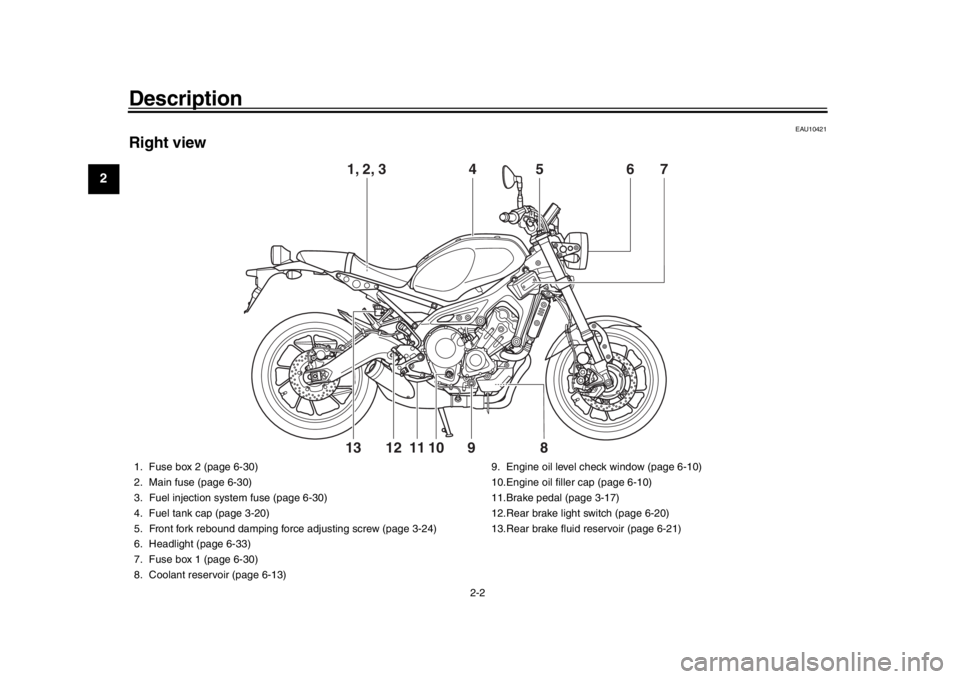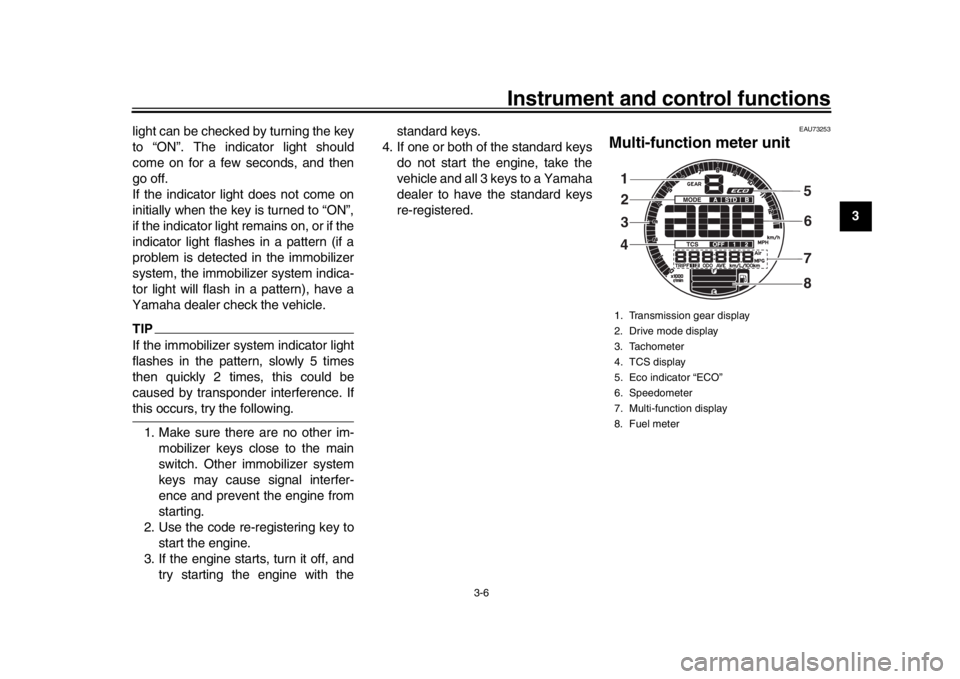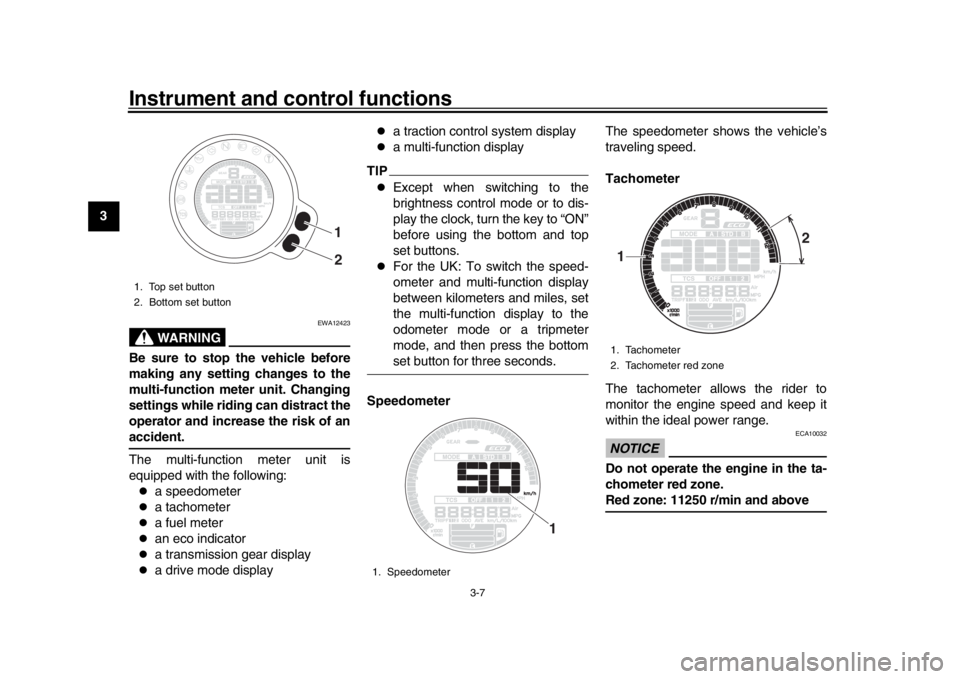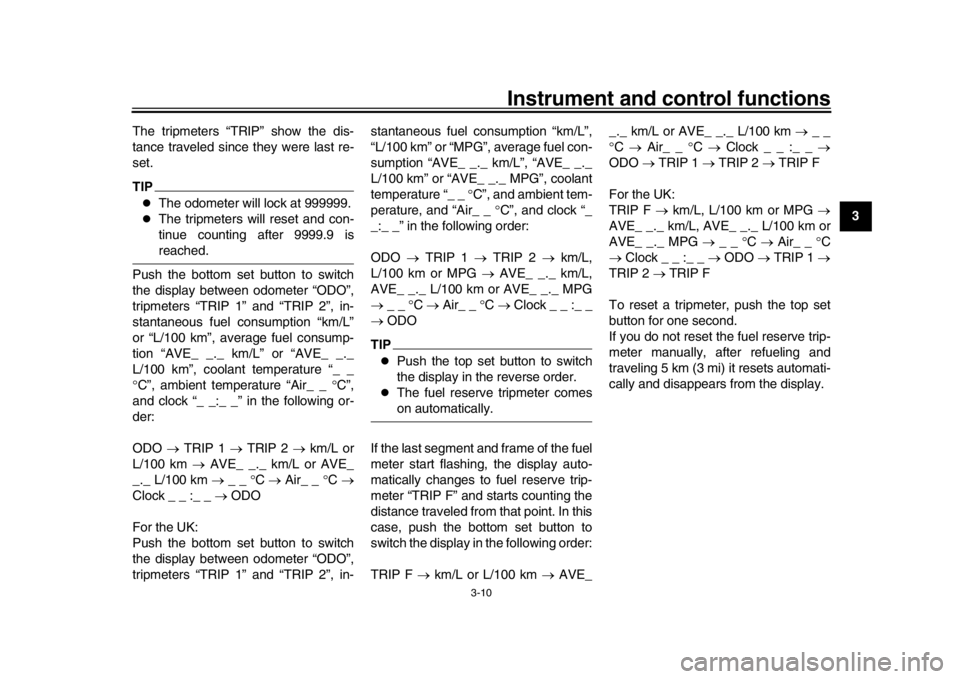fuel YAMAHA XSR 900 2017 Owners Manual
[x] Cancel search | Manufacturer: YAMAHA, Model Year: 2017, Model line: XSR 900, Model: YAMAHA XSR 900 2017Pages: 104, PDF Size: 7.42 MB
Page 6 of 104

Table of contentsSafety information........................... 1-1
Description ....................................... 2-1
Left view ......................................... 2-1
Right view ....................................... 2-2
Controls and instruments................ 2-3
Instrument and co ntrol functions... 3-1
Immobilizer system ..... .................... 3-1
Main switch/steering lock................ 3-2
Indicator lights and warning
lights ............................................ 3-4
Multi-function meter unit ................. 3-6
D-mode (drive mode).................... 3-13
Handlebar switches ...................... 3-14
Clutch lever................................... 3-16
Shift pedal..... ............................ .... 3-16
Brake lever ................................... 3-16
Brake pedal .................................. 3-17
ABS .............................................. 3-17
Traction control syst em ................ 3-18
Fuel tank cap ................................ 3-20
Fuel............................................... 3-20
Fuel tank breather hose and overflow hose ............................ 3-22
Catalytic converter ........................ 3-22
Seat .............................................. 3-23
Storage compartment ................... 3-24
Adjusting the front fork.................. 3-24
Adjusting the shock absorber assembly ................................... 3-26 Luggage strap holders .
................ 3-27
Sidestand ..................................... 3-28
Ignition circuit cut- off system ........ 3-28
Auxiliary DC connector................. 3-30
For your safety – pre-operation
checks .............................................. 4-1
Operation and important riding
points ................................................ 5-1
Starting the engine ......................... 5-1
Shifting ........................................... 5-2
Tips for reducing fuel consumption ............................... 5-3
Engine break-in .............................. 5-3
Parking ........................................... 5-4
Periodic maintenance and
adjustment ....................................... 6-1
Owner’s tool kit............................... 6-2
Periodic maintenance chart for the emission control system ....... 6-3
General maintenance and
lubrication chart .......................... 6-5
Checking the spark plugs ............... 6-9
Canister ........................................ 6-10
Engine oil and oil filter cartridge ... 6-10
Coolant ......................................... 6-13
Air filter element ........................... 6-15
Checking the engine idling speed ........................................ 6-15 Checking the throttle grip free
play ........................................... 6-15
Valve clearance ........................... 6-16
Tires ............................................. 6-16
Cast wheels ................................. 6-18
Adjusting the clutch lever free play ........................................... 6-19
Checking the brake lever free
play ........................................... 6-19
Brake light switches ..................... 6-20
Checking the front and rear
brake pads................................ 6-20
Checking the brake fluid level ...... 6-21
Changing the brake fluid .............. 6-22
Drive chain slack.......................... 6-23
Cleaning and lubricating the drive chain ................................ 6-24
Checking and lubricating the cables ....................................... 6-25
Checking and lubricating the
throttle grip and cable ............... 6-25
Checking and lubricating the brake and shift pedals .............. 6-26
Checking and lubricating the brake and clutch levers ............ 6-26
Checking and lubricating the sidestand .................................. 6-27
Lubricating the swingarm
pivots ........................................ 6-27
Checking the front fork................. 6-28
Checking the steering .................. 6-28B90-9-E1.book 1 ページ 2017年2月15日 水曜日 午後1時59分
Page 12 of 104

Safety information
1-5
1
2
3
4
5
6
7
8
9
10
11
12
Check that the fuel cock (if
equipped) is in the off position and
that there are no fuel leaks.
Shift the transmission into gear (for
models with a manual transmis-
sion).
Secure the motorcycle with
tie-downs or suitable straps that
are attached to solid parts of the
motorcycle, such as the frame or
upper front fork triple clamp (and
not, for example, to rubber-mount-
ed handlebars or turn signals, or
parts that could break). Choose
the location for the straps carefully
so the straps will not rub against
painted surfaces during transport.
The suspension should be com-
pressed somewhat by the
tie-downs, if possible, so that the
motorcycle will not bounce exces-
sively during transport.
B90-9-E1.book 5 ページ 2017年2月15日 水曜日 午後1時59分
Page 14 of 104

Description
2-2
12
3
4
5
6
7
8
9
10
11
12
EAU10421
Right view
4
5
6
7
10
9
11
12
8
13 1, 2, 3
1. Fuse box 2 (page 6-30)
2. Main fuse (page 6-30)
3. Fuel injection system fuse (page 6-30)
4. Fuel tank cap (page 3-20)
5. Front fork rebound damping force adjusting screw (page 3-24)
6. Headlight (page 6-33)
7. Fuse box 1 (page 6-30)
8. Coolant reservoir (page 6-13) 9. Engine oil level check window (page 6-10)
10.Engine oil fill
er cap (page 6-10)
11.Brake pedal (page 3-17)
12.Rear brake light switch (page 6-20)
13.Rear brake fluid reservoir (page 6-21)
B90-9-E1.book 2 ページ 2017年2月15日 水曜日 午後1時59分
Page 21 of 104

Instrument and control functions
3-6
1
234
5
6
7
8
9
10
11
12
light can be checked by turning the key
to “ON”. The indicator light should
come on for a few seconds, and then
go off.
If the indicator light does not come on
initially when the key is turned to “ON”,
if the indicator light remains on, or if the
indicator light flashes in a pattern (if a
problem is detected in the immobilizer
system, the immobili
zer system indica-
tor light will flash in a pattern), have a
Yamaha dealer check the vehicle.
TIPIf the immobilizer system indicator light
flashes in the pattern, slowly 5 times
then quickly 2 times, this could be
caused by transponder interference. Ifthis occurs, try the following.
1. Make sure there are no other im- mobilizer keys close to the main
switch. Other immobilizer system
keys may cause signal interfer-
ence and prevent the engine from
starting.
2. Use the code re-registering key to start the engine.
3. If the engine starts, turn it off, and try starting the engine with the standard keys.
4. If one or both of the standard keys do not start the engine, take the
vehicle and all 3 keys to a Yamaha
dealer to have the standard keys
re-registered.
EAU73253
Multi-function meter unit1. Transmission gear display
2. Drive mode display
3. Tachometer
4. TCS display
5. Eco indicator “ECO”
6. Speedometer
7. Multi-function display
8. Fuel meter1
32
4 5
6
8
7
B90-9-E1.book 6 ページ 2017年2月15日 水曜日 午後1時59分
Page 22 of 104

Instrument and control functions
3-7
1
23
4
5
6
7
8
9
10
11
12
WARNING
EWA12423
Be sure to stop the vehicle before
making any setting changes to the
multi-function meter unit. Changing
settings while riding can distract the
operator and increase the risk of anaccident.
The multi-function meter unit is
equipped with the following:
a speedometer
a tachometer
a fuel meter
an eco indicator
a transmission gear display
a drive mode display
a traction control system display
a multi-function display
TIP
Except when switching to the
brightness control mode or to dis-
play the clock, turn the key to “ON”
before using the bottom and top
set buttons.
For the UK: To switch the speed-
ometer and multi-function display
between kilometers and miles, set
the multi-function display to the
odometer mode or a tripmeter
mode, and then press the bottomset button for three seconds.
Speedometer The speedometer shows the vehicle’s
traveling speed.
Tachometer
The tachometer allows the rider to
monitor the engine speed and keep it
within the ideal power range.
NOTICE
ECA10032
Do not operate the engine in the ta-
chometer red zone.Red zone: 11250 r/min and above
1. Top set button
2. Bottom set button
1
2
1. Speedometer
1
1. Tachometer
2. Tachometer red zone1 2
B90-9-E1.book 7 ページ 2017年2月15日 水曜日 午後1時59分
Page 23 of 104

Instrument and control functions
3-8
1
234
5
6
7
8
9
10
11
12
Fuel meter
The fuel meter indicates the amount of
fuel in the fuel tank. The display seg-
ments of the fuel meter disappear from
“F” (full tank) towards “E” (empty tank)
as the fuel level decreases. When the
last segment and frame start flashing,
refuel as soon as possible.
TIPThis fuel meter is equipped with a
self-diagnosis system. If a problem is
detected in the fuel tank electrical cir-
cuit, the fuel level segments, frame,
and “ ” will flash repeatedly. If this oc-
curs, have a Yamaha dealer check the
vehicle.
Eco indicator
This indicator comes on when the vehi-
cle is being operated in an environmen-
tally friendly, fuel-efficient manner. The
indicator goes off when the vehicle is
stopped.TIPConsider the following tips to reduce
fuel consumption:
Avoid high engine speeds during
acceleration.
Travel at a constant speed.
Select the transmission gear that
is appropriate for the vehicle
speed.
Transmission gear display
This display shows the selected gear.
The neutral position is indicated by “ ”
and by the neutral indicator light.
1. Frame
2. Segment1
2
1. Eco indicator “ECO”
1
1. Neutral indicator light “ ”
2. Transmission gear display12
B90-9-E1.book 8 ページ 2017年2月15日 水曜日 午後1時59分
Page 24 of 104

Instrument and control functions
3-9
1
23
4
5
6
7
8
9
10
11
12 Drive mode display
This display indicates which drive
mode has been selected: “STD”, “A” or
“B”. For more details on the modes and
on how to select them, see pages 3-13
and 3-15.
TCS display
This display indicates which traction
control system setting has been select-
ed: “1”, “2” or “OFF”. For more details
on the TCS settings and on how to se-
lect them, see page 3-18.Multi-function display
The multi-function display is equipped
with the following:
an odometer
two tripmeters
a fuel reserve tripmeter
an instantaneous fuel consump-
tion display
an average fuel consumption dis-
play
a coolant temperature display
an air temperature display
a clock
a brightness level display
The odometer “ODO” shows the total
distance the vehicle has traveled.
1. Drive mode display
1
1. TCS display
1
1. Multi-function display
1
B90-9-E1.book 9 ページ 2017年2月15日 水曜日 午後1時59分
Page 25 of 104

Instrument and control functions
3-10
1
234
5
6
7
8
9
10
11
12
The tripmeters “TRIP” show the dis-
tance traveled since they were last re-
set.
TIP
The odometer will lock at 999999.
The tripmeters will reset and con-
tinue counting after 9999.9 isreached.
Push the bottom set button to switch
the display between odometer “ODO”,
tripmeters “TRIP 1” and “TRIP 2”, in-
stantaneous fuel consumption “km/L”
or “L/100 km”, average fuel consump-
tion “AVE_ _._ km/L” or “AVE_ _._
L/100 km”, coolant temperature “_ _
C”, ambient temperature “Air_ _ C”,
and clock “_ _:_ _” in the following or-
der:
ODO TRIP 1 TRIP 2 km/L or
L/100 km AVE_ _._ km/L or AVE_
_._ L/100 km _ _ C Air_ _ C
Clock _ _ :_ _ ODO
For the UK:
Push the bottom set button to switch
the display between odometer “ODO”,
tripmeters “TRIP 1” and “TRIP 2”, in- stantaneous fuel consumption “km/L”,
“L/100 km” or “MPG”, average fuel con-
sumption “AVE_ _._ km/L”, “AVE_ _._
L/100 km” or “AVE_ _._ MPG”, coolant
temperature “_ _
C”, and ambient tem-
perature, and “Air_ _ C”, and clock “_
_:_ _” in the following order:
ODO TRIP 1 TRIP 2 km/L,
L/100 km or MPG AVE_ _._ km/L,
AVE_ _._ L/100 km or AVE_ _._ MPG
_ _ C Air_ _ C Clock _ _ :_ _
ODO
TIP
Push the top set button to switch
the display in the reverse order.
The fuel reserve tripmeter comeson automatically.
If the last segment and frame of the fuel
meter start flashing, the display auto-
matically changes to fuel reserve trip-
meter “TRIP F” and starts counting the
distance traveled from that point. In this
case, push the bottom set button to
switch the display in the following order:
TRIP F km/L or L/100 km AVE_ _._ km/L or AVE_ _._ L/100 km
_ _
C Air_ _ C Clock _ _ :_ _
ODO TRIP 1 TRIP 2 TRIP F
For the UK:
TRIP F km/L, L/100 km or MPG
AVE_ _._ km/L, AVE_ _._ L/100 km or
AVE_ _._ MPG _ _ C Air_ _ C
Clock _ _ :_ _ ODO TRIP 1
TRIP 2 TRIP F
To reset a tripmeter, push the top set
button for one second.
If you do not reset the fuel reserve trip-
meter manually, after refueling and
traveling 5 km (3 mi) it resets automati-
cally and disappears from the display.
B90-9-E1.book 10 ページ 2017年2月15日 水曜日 午後1時59分
Page 26 of 104

Instrument and control functions
3-11
1
23
4
5
6
7
8
9
10
11
12 Instantaneous fuel consumption
The instantaneous fuel consumption
display can be set to either “km/L” or
“L/100 km”; or for the UK, to “MPG” as
well.
“km/L”: The distance that can be
traveled on 1.0 L of fuel under cur-
rent riding conditions.
“L/100 km”: The amount of fuel
necessary to travel 100 km under
current riding conditions.
“MPG”: The distance that can be
traveled on 1.0 Imp.gal of fuel un-
der current riding conditions.
To switch the instantaneous fuel con-
sumption display settings, push the
bottom set button for two seconds.
TIPIf traveling at speeds under 20 km/h (12mi/h), “_ _._” is displayed.
Average fuel consumption
This display shows the average fuel
consumption since it was last reset.
The average fuel consumption display
can be set to either “AVE_ _._ km/L” or
“AVE_ _._ L/100 km”, or for the UK, to
“AVE_ _._ MPG” as well.
“AVE_ _._ km/L”: The average dis-
tance that can be traveled on 1.0 L
of fuel.
“AVE_ _._ L/100 km”: The average
amount of fuel necessary to travel
100 km.
“AVE_ _._ MPG”: The average
distance that can be traveled on
1.0 Imp.gal of fuel.
To switch the average fuel consump-
tion display settings, push the bottom
set button for two seconds.
To reset the average fuel consumption,
push the top set button for one second.
TIPAfter resetting the average fuel con-
sumption, “_ _._” will be shown until thevehicle has traveled 1 km (0.6 mi).
Coolant temperature
This display shows the coolant temper-
ature from 40 C to 116 C in 1 C incre-
1. Instantaneous fuel consumption display
1
1. Average fuel consumption display
1
1. Coolant temperature display
1
B90-9-E1.book 11 ページ 2017年2月15日 水曜日 午後1時59分
Page 35 of 104

Instrument and control functions
3-20
1
234
5
6
7
8
9
10
11
12
EAU13075
Fuel tank capTo open the fuel tank cap
Open the fuel tank cap lock cover, in-
sert the key into the lock, and then turn
it 1/4 turn clockwise. The lock will be re-
leased and the fuel tank cap can be
opened.
To close the fuel tank cap 1. Push the fuel tank cap into position with the key inserted in the lock.
2. Turn the key counterclockwise to the original position, remove it, and
then close the lock cover.
TIPThe fuel tank cap cannot be closed un-
less the key is in the lock. In addition,
the key cannot be removed if the cap isnot properly closed and locked.
WARNING
EWA11092
Make sure that the fuel tank cap is
properly closed after filling fuel.Leaking fuel is a fire hazard.
EAU13222
FuelMake sure there is sufficient gasoline in
the tank.
WARNING
EWA10882
Gasoline and gasoline vapors are
extremely flammable. To avoid fires
and explosions and to reduce the
risk of injury when refueling, followthese instructions.
1. Before refueling, turn off the en- gine and be sure that no one is sit-
ting on the vehicle. Never refuel
while smoking, or while in the vi-
cinity of sparks, open flames, or
other sources of ignition such as
the pilot lights of water heaters and
clothes dryers.
2. Do not overfill the fuel tank. When refueling, be sure to insert the
pump nozzle into the fuel tank filler
hole. Stop filling when the fuel
reaches the bottom of the filler
tube. Because fuel expands when
it heats up, heat from the engine or
the sun can cause fuel to spill out
of the fuel tank.
1. Unlock.
2. Fuel tank cap lock cover
2
1
B90-9-E1.book 20 ページ 2017年2月15日 水曜日 午後1時59分